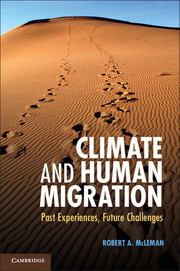Book contents
- Frontmatter
- Dedication
- Contents
- List of Figures
- List of Tables
- Preface
- Acknowledgments
- 1 An Introduction to the Study of Climate and Migration
- 2 Why People Migrate
- 3 Migration in the Context of Vulnerability and Adaptation to Climatic Variability and Change
- 4 Extreme Weather Events and Migration
- 5 River Valley Flooding and Migration
- 6 Drought and Its Influence on Migration
- 7 Mean Sea Level Rise and Its Implications for Migration and Migration Policy
- 8 Emergent Issues in Climate and Migration Research
- Annex Estimates of Global Population Exposed to Tropical Cyclones
- References
- Index
3 - Migration in the Context of Vulnerability and Adaptation to Climatic Variability and Change
Published online by Cambridge University Press: 05 December 2013
- Frontmatter
- Dedication
- Contents
- List of Figures
- List of Tables
- Preface
- Acknowledgments
- 1 An Introduction to the Study of Climate and Migration
- 2 Why People Migrate
- 3 Migration in the Context of Vulnerability and Adaptation to Climatic Variability and Change
- 4 Extreme Weather Events and Migration
- 5 River Valley Flooding and Migration
- 6 Drought and Its Influence on Migration
- 7 Mean Sea Level Rise and Its Implications for Migration and Migration Policy
- 8 Emergent Issues in Climate and Migration Research
- Annex Estimates of Global Population Exposed to Tropical Cyclones
- References
- Index
Summary
Introduction
Much of the existing research on climate and migration has its origins in scholarly fields not traditionally associated with mainstream migration research, such as natural hazards, human ecology, and climate change impacts and adaptation research. Current studies tend to treat migration as one of a range of possible outcomes when vulnerable individuals, households, and communities adjust and adapt to climatic events and conditions or to changes in prevailing conditions. Treating migration in this way is consistent with how it has evolved within the reporting processes of the Intergovernmental Panel on Climate Change (IPCC) and the structure of the United Nations Framework Convention on Climate Change (UNFCCC). It is also conceptually logical to do so, given that the cultural, economic, political, and social forces believed to shape vulnerability and the capacity to adapt are similar to those that have a strong influence on migration behavior. The present chapter covers a considerable amount of ground, describing key theories of vulnerability and adaptation used in climate impacts research, and combining these with key theories and concepts developed in migration scholarship to show how migration occurs within the context of dynamic, adaptive, human-environment interactions.
In particular, this chapter:
Explains the specific meanings of vulnerability and adaptation, their implications under the UNFCCC, and why this is relevant;
Traces the origins of vulnerability and adaptation as they are presently understood and describes their development;
Shows how vulnerability and adaptation are influenced by cultural, economic, environmental, political, and social forces similar to those that shape migration behavior;
Details how household-level adaptation options are shaped and the place of migration within those options;
Shows how access to economic, social, and other forms of capital is an important determinant of how adaptation processes play out;
Creates a diagrammatic representation of how migration may emerge within dynamic processes of adaptation, which is used in later chapters to interpret migration outcomes in response to a range of climatic phenomena.
- Type
- Chapter
- Information
- Climate and Human MigrationPast Experiences, Future Challenges, pp. 49 - 76Publisher: Cambridge University PressPrint publication year: 2013



